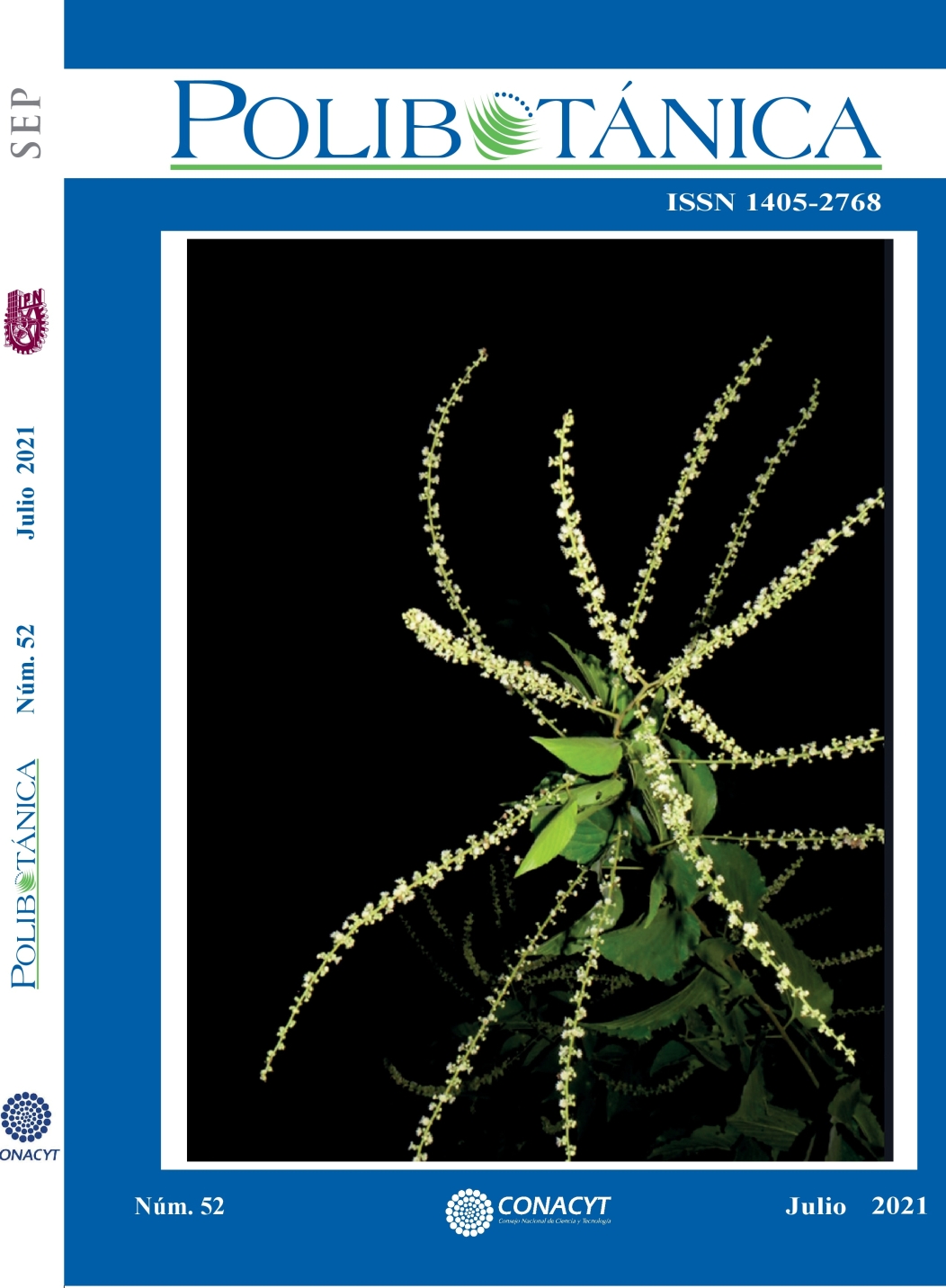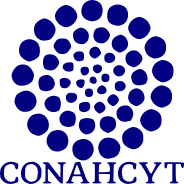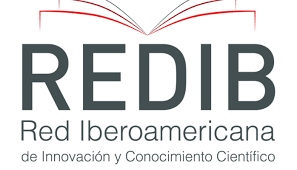Proximal comparison in cocoa (Theobroma cacao) and pataxte (T. bicolor) of Tabasco and Chiapas, Mexico
DOI:
https://doi.org/10.18387/polibotanica.52.10Keywords:
Bromatological analysis, Fat content, cocoa, pataxte, proteinAbstract
In Mexico, the main cocoa (Theobroma cacao) and pataxte (T. bicolor) producing areas are in Tabasco and Chiapas states. Cacao and pataxte are consumed in different ways; the most common is the mixture corn and cacao (pozol). The aim of this study was to carry out the proximal analysis of cocoa varieties: Guayaquil, Criollo, Calabacillo, Patastillo, and Pataxte. Cocoa and pataxte were collected in 43 localities in Tabasco and Chiapas. The collections were determined: moisture content, protein, ash, fat, fiber, and carbohydrates. With the means of the evaluated characteristics, Duncan's mean comparison test, and multivariate principal component (PCA) and cluster (AC) analyzes were performed. No differences were found for ash and carbohydrates content between cocoa and pataxte studied. Regarding fiber and moisture content, pataxte presented differences (3.1 ± 0.8 and 20.5 ± 12.0 g / 100g), while Calabacillo and Patastillo showed more protein content (18.9 ± 7.5 and 17.2 ± 6.1 g / 100g), the highest content of carbohydrates and the lowest fiber corresponded to “Guayaquil” variety (37.3 ± 11.9 and 1.8 ± 0.6 g / 100g). The results found in this research present a general panorama of cocoa and pataxte proximal content that are cultivated in the states of Tabasco and Chiapas, and based on this they can be selected according to the attribute of interest that the producer requires.
References
Álvarez, C., Tovar, L., García, H., Morillo, F., Sánchez, P., Girón, C., & De Farias, A. (2010). Evaluación de la calidad comercial del grano de cacao (Theobroma cacao L.) usando dos tipos de fermentadores. Revista Científica UDO Agrícola, 10(1), 76–87.
AOAC. (2012). Official Methods of Analysis of AOAC International. In AOAC International.
Arriaga, C. . (2007). Contenido de ácidos grasos de la manteca proveniente de mezclas en distintas fracciones de semillas de Theobroma cacao y Theobroma bicolor y su uso en la manufactura de chocolate. In Facultad de ciencias químicas y farmacia, Universidad de San Carlos de Guatemala.
Avendaño, A. C. H., Villarreal, J. M., Campos, E., Gallardo, R. A., Mendoza, A., Aguirre, J. F., Sandoval, E., & Espinoza, Z. (2011). Diagnóstico del cacao en México.
Blanco, L. (2020). Cacao: historia, características, hábitat, variedades, propiedades. Lifeder. https://www.lifeder.com/#_Registros_de_su_origen
Caballero-Pérez, J. F., Hernández-Hernández, C., & Avendaño-Arrazate, C. H. (2014). La fermentación y el secado al sol de granos de cacao. In INIFAP, Folleto Técnico.
Cáceres, J. (2015). El secreto prehispánico de la espuma del Pataxte. Revista Delicias Prehispánicas. https://deliciasprehispanicas.com/2015/12/01/balam-te-el-secrecto-prehispanico-de-la-espuma-del-chocolate/
Całkosiński, A., Kostrzewska, P., Majewski, M., Mandera, A., Pawlikowska, A., & Szuster, E. M. (2019). Impact of cocoa on the human health. Journal of Education, Health and Sport, 9(5), 145–154. https://doi.org/http://dx.doi.org/10.5281/zenodo.2718725
Cervantes-Martinez, C., Brown, J. S., Schnell, R. J., Phillips-Mora, W., Takrama, J. F., & Motamayor, J. C. (2006). Combining ability for disease resistance, yield, and horticultural traits of cacao (Theobroma cacao L.) clones. Journal of the American Society for Horticultural Science. https://doi.org/10.21273/jashs.131.2.231
Chafla, A. L., Rodríguez, Z., Boucourt, R., & Torres, V. (2016). Caracterización bromatológica de la cáscara de cacao (Theobroma cacao), procedente de siete cantones de la Amazonia, Ecuador. Cuban Journal of Agricultural Science, 50(2), 245–252.
Chappell, A., Scott, K. P., Griffiths, I. A., Cowan, A. A., Hawes, C., Wishart, J., & Martin, P. (2017). The agronomic performance and nutritional content of oat and barley varieties grown in a northern maritime environment depends on variety and growing conditions. Journal of Cereal Science, 74, 1–10. https://doi.org/10.1016/j.jcs.2017.01.005
Dong, Y., Chen, L., Gutin, B., & Zhu, H. (2019). Total, insoluble, and soluble dietary fiber intake and insulin resistance and blood pressure in adolescents. European Journal of Clinical Nutrition, 73(8), 1172–1178. https://doi.org/10.1038/s41430-018-0372-y
Ferreyra, R., Defilippi, B., Saavedra, J., Selles, G., Robledo, P., Arpaia, M. L., Karlezi, D., Crane, J., Schaffer, B., & Gil, P. (2012). Predictores del comportamiento en postcosecha de la palta, proveniente de diferentes condiciones de clima, suelo y manejo.
Gálvez-Marroquín, L., Reyes-Reyes, A., Avendaño-Arrazate, C., Hernández-Gómez, E., Mendoza-Lopez, A., & Díaz-Fuentes, V. (2016). Pataxte (Theobroma bicolor Humb. & Bonpl.): Especie subutilizada en México. Agroproductividad, 9(1), 41–47.
González-Coral, A., & Torres-Reyna, G. M. (2010). Manual de cultivo del Macambo (Theobroma bicolor Humb & Bonpl.). In IIAP.
González, A. A., Moncada, J., Idarraga, A., Rosenberg, M., & Cardona, C. A. (2016). Potential of the amazonian exotic fruit for biorefineries: The Theobroma bicolor (Makambo) case. Industrial Crops and Products, 86, 58–67. https://doi.org/10.1016/j.indcrop.2016.02.015
Kaiser, H. F. (1960). The application of electronic computers to factor analysis. Educational and Psychological Measurement, 20, 141–151. https://doi.org/10.1177/001316446002000116
Liendo, R., Padilla, F. C., & Quintana, A. (1997). Characterization of cocoa butter extracted from Criollo cultivars of Theobroma cacao L. Food Research International, 30(9), 727–731. https://doi.org/10.1016/S0963-9969(98)00025-8
Machado, L., Ordoñez, C. M., Ángel, Y. K., Guaca, L., & Suárez, J. C. (2018). Organoleptic quality assessment of Theobroma cacao L. in cocoa farms in northern Huila, Colombia. Acta Agronomica, 67(1), 46–52. https://doi.org/10.15446/acag.v67n1.66572
Martini, M. H., Lenci, C. G., Figueira, A., & Tavares, D. Q. (2008). Localization of the cotyledon reserves of Theobroma grandiflorum (Willd. ex Spreng.) K. Schum., T. subincanum Mart., T. bicolor Bonpl. and their analogies with T. cacao L. Revista Brasileira de Botanica, 31(1), 147–154. https://doi.org/10.1590/S0100-84042008000100013
Nájera, M. I. (2011). El mono y el cacao: la búsqueda de un mito a través de los relieves del grupo de la serie inicial de Chichén Itzá. In CEMIIF, UNAM. Estudios de Cultura Maya, UNAM.
Ozung, P. O., Kennedy, O. O., & Agiang, E. A. (2016). Chemical Composition of Differently Treated Forms of Cocoa POD Husk Meal (CPHM). Asian Journal of Agricultural Sciences, 8(2), 5–9. https://doi.org/10.19026/ajas.8.2912
Pérez, E., Álvarez, C., & Lares, M. (2002). Caracterización física y química de granos de cacao fermentados, secos y tostados de la región de Chuao. Agronomía Tropical, 52(2), 161–172.
Pires, T. C., Melo, T. S., Miranda, L. C., & Bispo, E. S. (2016). Exploratory analysis for cocoa bean variety identification using colorimetricand anthocyanin variables. XXV Congresso Brasileiro de Ciencia e Tecnología de Alimentos, 6.
Quinteros, V., Quinteros, A., Chumacero, J., & Castro, P. (2018). Effect of temperature and toasting time on the acceptability of macambo food paste (Theobroma bicolor Humb. & Bonpl.). Agroindustrial Science, 8(1), 27–31. https://doi.org/10.17268/agroind.science.2018.01.04
Rojas, R., Rodríguez, C., Ruiz, C., Portales, R., Neyra, E., Patel, K., Mogrovejo, J., Salazar, G., & Hurtado, J. (2017). Cacao chuncho del Cusco. In Universidad Peruana Cayetano Heredia. Universidad Peruana Cayetano Heredia. https://doi.org/10.21757/0103-3816.2018v30n3p157-174
Rojo-Poveda, O., Barbosa-Pereira, L., Zeppa, G., & Stévigny, C. (2020). Cocoa bean shell: a by-product with nutritional properties and biofunctional potential. Nutrients, 12, 1123–1152. https://doi.org/10.3390/nu12041123
Sánchez Gutiérrez, F., Pérez-Flores, J., Obrador Olan, J. ., Sol Sánchez, Á., & Ruiz-Rosado, O. (2017). Estructura arbórea del sistema agroforestal cacao en Cárdenas, Tabasco, México. Revista Mexicana de Ciencias Agrícolas, 14, 2695–2709. https://doi.org/10.29312/remexca.v0i14.439
SAS, I. (2017). Sas® 9.4. In SAS Institute Inc. Cary, NC, US. SAS Institute.
Schnell, R. J., Olano, C. T., Brown, J. S., Meerow, A. W., Cervantes-Martinez, C., Nagai, C., & Motamayor, J. C. (2005). Retrospective determination of the parental population of superior cacao (Theobroma cacao L.) seedlings and association of microsatellite alleles with productivity. Journal of the American Society for Horticultural Science. https://doi.org/10.21273/jashs.130.2.181
Sifuentes, S. M. A. (2017). Evaluación físico-química de la pulpa y semilla de dos morfotipo del fruto de Macambo “Theobroma bicolor (Humb. & Bonpl.)” de la región Loreto. Universidad Nacional de la Amazonia Peruana.
Sol-Sánchez, Á., Naranjo-González, J. A., Córdova-Avalos, V., Ávalos-de la Cruz, D. A., & Zaldívar-Cruz, J. M. (2017). Caracterización bromatológica de los productos derivados de cacao (Theobroma cacao L.) en la Chontalpa, Tabasco, México. Revista Mexicana de Ciencias Agrícolas, 14, 2817–2830. https://doi.org/10.29312/remexca.v0i14.453
Sotelo, A., & Alvarez, R. G. (1991). Chemical Composition of Wild Theobroma Species and Their Comparison to the Cacao Bean. Journal of Agricultural and Food Chemistry, 39(11), 1940–1943. https://doi.org/10.1021/jf00011a009
Systat. (2006). Sigma Plot (No. 10). Systat Software.
Tigrero, J. B., & Sanclemente, A. B. (2018). Sustitución de Theobroma cacao por Theobroma (Pataxte) y su Aplicación en repostería. In Universidad de Guayaquil. Universidad de Guayaquil.
Vela, E. (2020). El cacao... un fruto asombroso... y el chocolate, el sabor mexicano del mundo. Arqueología Mexicana.
Vera-Chang, J. F., Vallejo-Torres, C., Párraga-Morán, D. E., Macías-Véliz, J., Ramos-Remache, R., & Morales-Rodríguez, W. (2015). Atributos físicos-químicos y sensoriales de las almendras de quince clones de cacao nacional (Theobroma cacao L.) en el Ecuador. Ciencia y Tecnología, 7(2), 21–34. https://doi.org/10.18779/cyt.v7i2.99
Vera-Zambrano, M., Dutta, B., Mercer, D. G., MacLean, H. L., & Touchie, M. F. (2019). Assessment of moisture content measurement methods of dried food products in small-scale operations in developing countries: A review. Trends in Food Science and Technology, 88, 484–496. https://doi.org/10.1016/j.tifs.2019.04.006
Downloads
Published
Issue
Section
License

Polibotánica by Departamento de Botánica de la Escuela Nacional de Ciencias Biológicas del Instituto Politécnico Nacional se distribuye bajo una Licencia Creative Commons Atribución-NoComercial-CompartirIgual 4.0 Internacional.




















